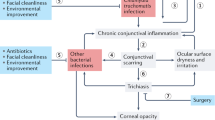Abstract
Trachoma causes one-quarter of the world's blindness and, although it has disappeared from many developed areas, it remains a major problem, especially in underprivileged rural areas in developing countries. Recent advances in the understanding of the molecular biology of chlamydia offer encouragement for the eventual development for an effective trachoma vaccine. Advances in the understanding of the epidemiology of trachoma, particularly of the importance of reinfection and the intrafamily transmission of infection, have led to the identification of the key importance of simple hygiene measures such as facial cleanliness in preventing the transmission of trachoma. Community-based health education intervention programs are being developed to assess the efficacy of a public health approach to the control of trachomatous blindness.
Similar content being viewed by others
References
Danilition SL, MacLean IW, Peeling R, Winston S, Brunham RC. The 75 kilodalton protein of Chlamydia trachomatis: a member of the heat shock protein 70 family? Infect Immun 1990; 58: 189–96.
Dawson CR, Jones BR, Tarizzo ML. Epidemiology. In: Guide to trachoma control. Geneva, World Health Organization 1981: 21–4.
Grayston JT, Wang S. New knowledge of chlamydiae and the diseases they cause. J Infect Dis 1975; 132: 87–105.
Grayston JT, Wang S-P, Yeh LJ, Kuo CC. Importance of reinfection in the pathogenesis of trachoma. Rev Infect Dis 1985; 7: 717–25.
Millar MI, Lane SD. Ethno-ophthalmology in the Egyptian Delta: an historical systems approach to ethnomedicine in the Middle East. Soc Sci Med 1988; 26: 651–7.
Morrison RP, Lyng K, Caldwell HD. Chlamydial disease pathogenesis. J Exp Med 1989; 169: 663–75.
Newhall WJV. Macromolecular and antigenic composition of chlamydiae. Chlamydia as organisms. Chapter 3. In: Barron AL, ed. Microbiology of Chlamydia. Boca Raton: CRC Press, Inc 1988: 47–70.
Oriel JD. Chemotherapy. In: Oriel D, Ridgway G, Schachter J, Taylor-Robinson L, Ward M, eds. Chlamydial Infections, Proceedings of the Sixth International Symposium on Human Chlamydial Infections. Cambridge, Cambridge University Press 1986: 513–23.
Rank RG. Role of the immune response. Chlamydia as pathogens, Chapter 12. In: Barron AL, ed. Microbiology of Chlamydia. Boca Raton: CRC Press, Inc 1988: 217–34.
Reacher MH, Huber MJE, Canagaratnam R, Alghassany A. A trial of surgery for trichiasis of the upper lid from trachoma. Br J Ophthalmol (in press).
Schachter J. Chlamydial infections, Part 1, 2, and 3. N Engl J Med 1978; 298: 428–549.
Schachter J. Overview of human diseases. Chlamydia as pathogens, Chapter 8. In: Barron AL, ed. Microbiology of Chlamydia. Boca Raton: CRC Press, Inc 1988: 153–65.
Schachter J, Moneada J, Dawson CR, Sheppard J, Courtright P, Said ME, Zaki S, Hafez SF, Lorincz A. Nonculture methods for diagnosing chlamydial infection in patients with trachoma: a clue to the pathogenesis of the disease? J Infect Dis 1988; 158: 1347–52.
Taylor HR. Strategies for the control of trachoma. Aust NZ J Ophthalmol 1987; 15: 139–43.
Taylor HR. Trachoma research: laboratory and epidemiologic aspects. Int Rev Trach 1987: 23-58.
Taylor HR, Johnson SL, Schachter J, Caldwell HD, Prendergast RA. Pathogenesis of trachoma: the stimulus for inflammation. J Immunol 1987; 38: 3023–7.
Taylor HR, Millan-Velasco F, Sommer A. The ecology of trachoma: an epidemiological study of trachoma in Southern Mexico. Bull WHO 1985; 63: 559–67.
Taylor HR, Rapoza PA, Johnson S, Muñoz B, Katala S, Mmbaga BBO, West S. The epidemiology of infection in trachoma. Invest Ophthalmol Vis Sci 1989; 30: 1823–33.
Taylor HR, Whittum-Hudson J, Schachter J, Caldwell HD, Prendergast RA. Oral immunization with chlamydial major outer membrane protein (MOMP). Invest Ophthalmol Vis Sci 1988; 29: 1847–53.
Thylefors B, Dawson CR, Jones BR, West SK, Taylor HR. A simple system for the assessment of trachoma and its complications. Bull WHO 1987; 65: 477–83.
Watkins NG, Hadlow WJ, Moos AB, Caldwell HD. Ocular delayed hypersensitivity: a pathogenetic mechanism of chlamydial conjunctivitis in guinea pigs. Proc Natl Acad Sci USA 1986; 83: 7480–4.
West S, Lynch M, Turner V, Muñoz B, Rapoza P, Mmbaga BBO, Taylor HR. Water availability and trachoma. Bull WHO 1989; 67: 71–5.
West S, Taylor HR. Community-based intervention programs for trachoma control. International Ophthalmology 1988; 12: 19–23.
Zhang YX, Stewart S, Joseph T, Taylor HR, Caldwell HD. Protective monoclonal antibodies recognize epitopes located on the major outer membrane protein of Chlamydia trachomatis. J Immunol 1987; 138: 575–81.
Author information
Authors and Affiliations
Additional information
Supported in part by Research to Prevent Blindness, William and Mary Greve International Research Scholar grant.
Rights and permissions
About this article
Cite this article
Taylor, H.R. Trachoma. Int Ophthalmol 14, 201–204 (1990). https://doi.org/10.1007/BF00158319
Accepted:
Issue Date:
DOI: https://doi.org/10.1007/BF00158319




